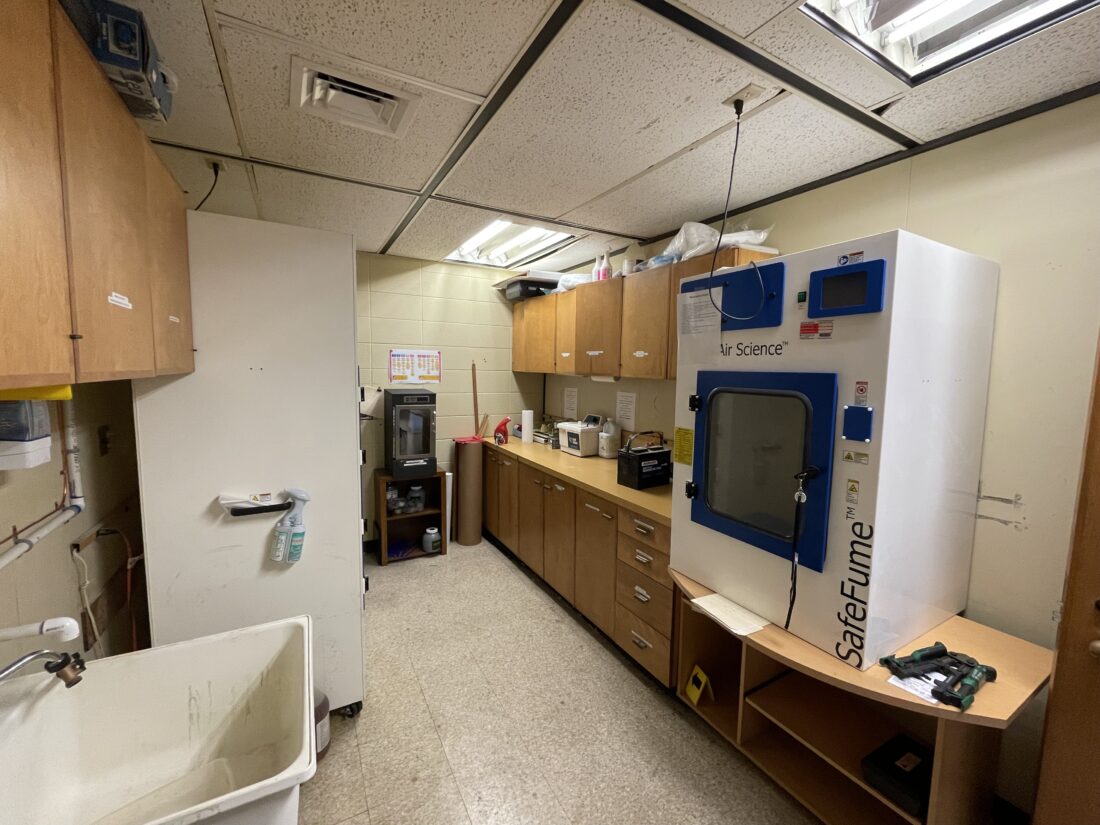Plan to renovate Judicial and Law Enforcement Center would move some services to a new home, make more room for courts

photo by: Chris Conde/Journal-World
The Douglas County Judicial and Law Enforcement Center is pictured in May of 2023. The center houses the Douglas County District Court and other county services.
As Douglas County leaders consider spending tens of millions of dollars to renovate the Judicial and Law Enforcement Center, they’re saying it’s not just about making courts run better — it’s about giving 911 services a new home base, making the sheriff’s office more efficient and even keeping county residents safe during natural disasters.
And with the plan they’re currently leaning toward, they’d be able to do it without raising taxes, according to County Administrator Sarah Plinsky.
The Judicial and Law Enforcement Center building, located at 111 E. 11th St., will turn 50 years old in 2025 and is home not only to Douglas County District Court, but also some Douglas County Sheriff’s Office personnel and the Douglas County District Attorney’s Office, as well as vital services such as Emergency Communications, the county’s 911 call center. It’s also the hub for Douglas County Emergency Management, where emergency responders and local government leaders meet and operate during crises like floods and tornadoes.
Jay Zimmerschied, Douglas County’s director of capital projects, says the diverse mix of departments in the three-floor, 100,000-square-foot building is a reminder of the time when it was built.
“I think it’s indicative of a community that’s grown up,” Zimmerschied said. “Back in the ’70s, it wasn’t uncommon to have all these functions kind of in one building. But there’s probably not another group in the state that has all of these various departments and groups in their courthouse.”
That’s led to an awkward situation where some of the services in the building need more room to grow, and others are spread out across multiple floors — or are even split between the JLEC and other buildings in a way that makes it more difficult to operate.
The sheriff’s office has been divided between the JLEC and the Douglas County Jail since the latter facility was built in 1999. The Douglas County District Attorney’s Office uses spaces on three floors of the building and still says it doesn’t have enough room. And Zimmerschied said there are even some services in the building whose office spaces are full of stacks of boxes and supplies, because the building doesn’t have enough closet space.
To remedy these issues, Plinsky said the county is considering a plan that would at least move the Sheriff’s Office, Emergency Communications and Emergency Management out of the building, and that could also move Community Corrections offices to a nearby building at 1006 New Hampshire St. to free up even more space. Zimmerschied said the county could then reorganize the JLEC building to reflect “best practices” for each service or department housed there.
The project is still early in the planning process, and its financial picture isn’t entirely clear. As the Journal-World reported, as recently as September, county commissioners were hearing about a set of renovation options that, depending on their scope, would cost between $105 million and about $120 million and wouldn’t require a tax increase
Plinsky said earlier this month that the county still has several options on the table for the renovation plans, but that one of the plans leaders are leaning toward has a price tag of around $70 million for initial improvements to the JLEC and would also spend more than $30 million to build a new building for the sheriff’s office and other relocated services. The total project would not require the county to introduce any new taxes, she said. Instead, she said the plan would use the county’s reserves of about $12 million to get the project started, and the county would borrow the remaining money and repay it over the next two decades using a portion of the county’s annual tax revenue.

photo by: Douglas County
The Sheriff’s Office IT room is pictured on Nov. 3, 2023, at the Douglas County Judicial and Law Enforcement Center. The IT staff shares their staff with incoming packages and supplies.
A new building for emergency responders
On Dec. 13, county commissioners will have another work session on what the plans for the JLEC could look like — and what the future might hold for the sheriff’s office, Emergency Management and Emergency Communications when they leave.
Under the plan county leaders are leaning toward, those services wouldn’t just be kicked out — they’d have a new building constructed specifically to house them.
“Those three functions only take up 23,000 square feet in the (JLEC) building,” Plinsky said. “The building is right around 100,000 square feet, all three levels, all in. So if they leave, that’s just 23,000 square feet. It helps.”
The move wouldn’t just be about freeing up space. For Emergency Management and 911 services, it might one day be a matter of safety, too.
The current second-floor location isn’t ideal for communications or management during a weather crisis like a tornado. Those services should be housed in secure facilities rated for disasters, Plinsky said.

photo by: Douglas County
Multiple services gather to respond to a tornado in Douglas County on May 28, 2019 in the Douglas County Emergency Operations Center. The center is used to coordinate emergency response and recovery efforts.

photo by: Douglas County
The Emergency Communications Center is pictured on Nov. 3, 2023, on the second floor of the Judicial and Law Enforcement Center.
“Moving dispatch out is a pretty expensive move,” she said, because of the protections it needs. “It’s not just regular office space; we’d have to move the towers, the backup generators, it has to be tornado rated.”
As far as the sheriff’s office goes, moving out would be an opportunity to make the office “whole” again, Sheriff Jay Armbrister said. When the new jail was built in 1999, it divided the office into two buildings that aren’t that close to each other.
Armbrister said that “a move to a location next to our current jail would place our patrol division in a much more accessible location for responses, thus cutting response times.”
He also said that by bringing all of the sheriff’s office’s services under one roof, things like training and work on patrol vehicles and other technology could be done in a secure location, instead of in the parking lot of the JLEC.
It would also save the sheriff’s office about $25,000 a year that it currently pays to rent space for the county’s Underwater Dive and Recovery Team equipment, Armbrister said.
Court impacts
Though the jail wouldn’t be expanded as part of the proposed upgrades, Armbrister said remodeling the JLEC could help alleviate the jail’s crowding issues, but in a different way: Instead of making more room to house inmates, it would help their cases go through the court system faster and more efficiently.
In addition to moving some agencies out of the JLEC, the plan Plinsky spoke about would add 70,000 square feet to the existing building, including space for new, larger courtrooms. With that added space, the county hopes it can consolidate some services like the District Attorney’s Office, which is currently spread across all three floors of the building.
“We have staff located across three floors. At any point during the day, we can have witnesses, victims and defense attorneys within our workspaces because we do not have adequate room,” said Cheryl Cadue, spokesperson for the DA’s office. “This project is the best opportunity for the DA’s Office to centralize staff while providing much needed secure spaces for the public and staff.”
It’s also a good way to prepare the county for its future court caseloads, Plinsky said. While Douglas County was recently given funds by the state to add a district court judge, its caseloads are still among the highest in the state, and extra courtrooms and judges would mean more cases could be handled at once.
“My hope is that means that we get additional judges in the future, because I think they’re going to be hard pressed to add them for other districts and not add one for us,” Plinsky said.
That’s especially important as Armbrister’s jail staff handles more and more inmates with serious charges against them. He said that currently, “the makeup of our inmate population is almost exclusively high-level offenders and persons who pose a significant threat to both themselves, other incarcerated persons and our staff.” The way to get those people out of the jail is to finish up their cases more quickly.
“This could move folks toward a disposition of their case quicker or on to prison, creating room for any others who might be remanded or sentenced to our jail,” Armbrister said.
Court security is also one of the big topics of discussion for the remodeling project.
Plinsky said that the problem with the current layout of the building is that “level one is the main floor and everybody travels along the same path.”
“And if you’ve read any stories about courthouses where there’s been a shooting or some sort of problem, it’s because you have people that are not necessarily happy to be in the same space together,” Plinsky said.
Not only is it a safety concern for potentially dangerous defendants to share the same hallway as someone having a civil suit or protection from abuse hearing, but there could also be legal complications if a juror were to see a defendant in shackles before a trial and make a judgment based on that, Plinsky said.
To fix these problems, the remodeling project would redesign the building’s circulation patterns. Designers would work to get away from the current flow, in which the main hallway is shared by the public, attorneys, court staff and in-custody defendants.
A small courtroom with limited access points has posed a security problem at least once in 2023, at an immunity hearing in June for Derrick Del Reed, 18, who is charged with first-degree murder in connection with the shooting death of 14-year-old Kamarjay Shaw. At the hearing, Reed’s and Shaw’s supporters clashed verbally in the close quarters of the packed courtroom and hallways, eventually spilling onto the courthouse lawn and prompting a lockdown at the building. The head of court security, sheriff’s office Lt. Chris Johnston, previously described that scene as “chaos”.

photo by: Chris Conde/Journal-World
Sheriff’s deputies stand at the ready behind a steel security door that was closed after multiple outbursts during a self defense hearing for 17-year-old Derrick Del Reed. on June 2, 2023, in Douglas County District Court. The door was closed after attendees were asked to leave the courtroom and to watch the hearing on Youtube.
Chief Judge James McCabria said the security problem is compounded by the space issues and that a remodel would make the entire court experience better for the public and those working inside. He said while most court proceedings may not result in a packed house, having the means to accommodate all hearings is important.
“All proceedings are important, and when we can’t accommodate the needs of a particular proceeding, it is frustrating for everyone involved and raises concerns about whether compromises are impacting the purpose and goal of the proceeding,” McCabria said.
Beyond the comfort and functionality of the courts, the remodel would also update the building in other ways, including improved accessibility for people with disabilities, McCabria said.
It’s all part of ensuring that the old building — which Plinsky and Zimmerschied said cost about $4 million to build in 1975 — can keep serving the public for decades to come.
“The building has served the community well over the last 50 years and will continue to,” Plinsky said of the building, which will be be eligible for the historical registry in 2025. “It just needs pretty substantial renovation and a little bit of extra space. I think it will last us another 50 years. The bones are good.”

photo by: Douglas County
An evidence processing room used by the Sheriff’s Office where cabinet work from the building’s original construction can be seen. The processing room is several doors and hallways away from where evidence is stored in the building.







